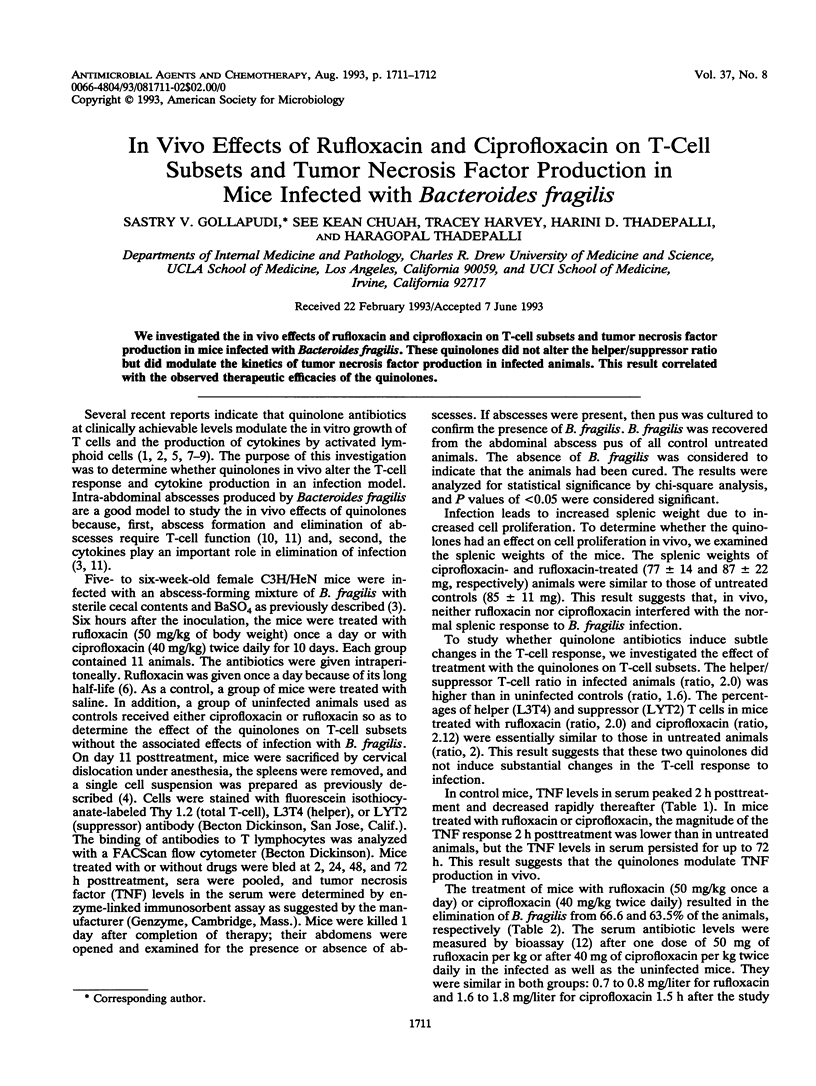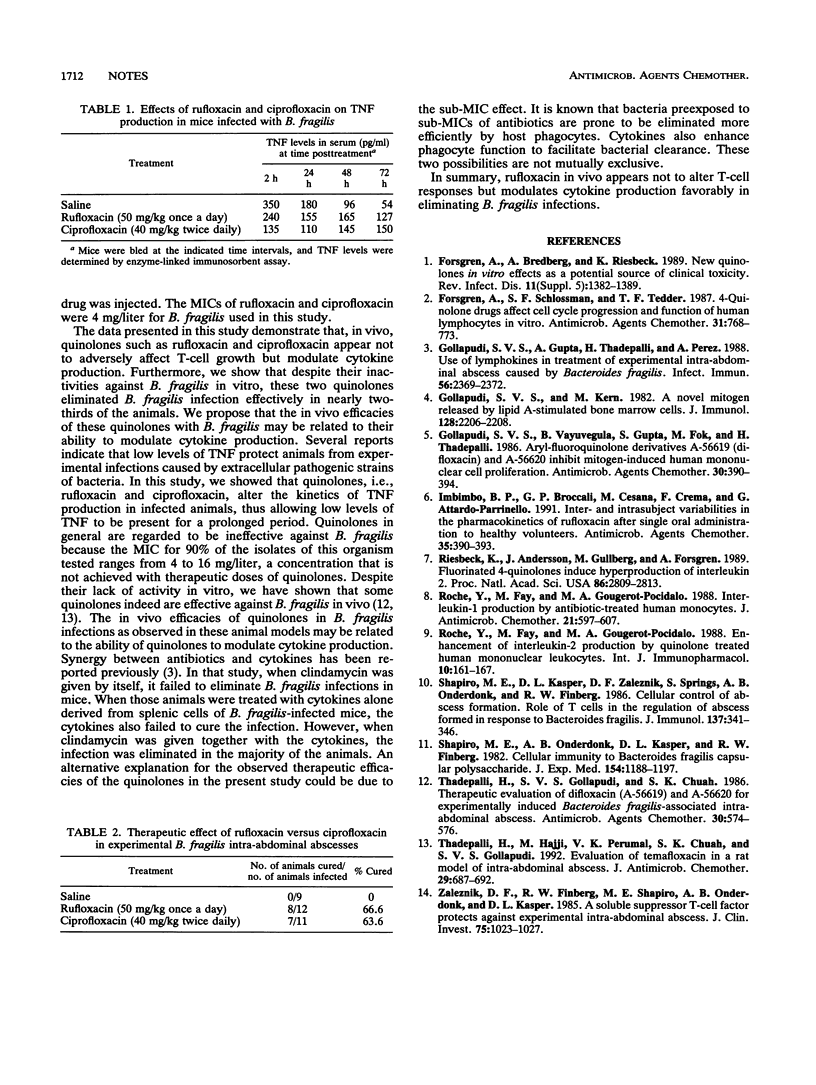Abstract
We investigated the in vivo effects of rufloxacin and ciprofloxacin on T-cell subsets and tumor necrosis factor production in mice infected with Bacteroides fragilis. These quinolones did not alter the helper/suppressor ratio but did modulate the kinetics of tumor necrosis factor production in infected animals. This result correlated with the observed therapeutic efficacies of the quinolones.
Full text
PDF

Selected References
These references are in PubMed. This may not be the complete list of references from this article.
- Forsgren A., Schlossman S. F., Tedder T. F. 4-Quinolone drugs affect cell cycle progression and function of human lymphocytes in vitro. Antimicrob Agents Chemother. 1987 May;31(5):768–773. doi: 10.1128/aac.31.5.768. [DOI] [PMC free article] [PubMed] [Google Scholar]
- Gollapudi S. V., Gupta A., Thadepalli H., Perez A. Use of lymphokines in treatment of experimental intra-abdominal abscess caused by Bacteroides fragilis. Infect Immun. 1988 Sep;56(9):2369–2372. doi: 10.1128/iai.56.9.2369-2372.1988. [DOI] [PMC free article] [PubMed] [Google Scholar]
- Gollapudi S. V., Kern M. A novel mitogen released by lipid A-stimulated bone marrow cells. J Immunol. 1982 May;128(5):2206–2208. [PubMed] [Google Scholar]
- Gollapudi S. V., Vayuvegula B., Gupta S., Fok M., Thadepalli H. Aryl-fluoroquinolone derivatives A-56619 (difloxacin) and A-56620 inhibit mitogen-induced human mononuclear cell proliferation. Antimicrob Agents Chemother. 1986 Sep;30(3):390–394. doi: 10.1128/aac.30.3.390. [DOI] [PMC free article] [PubMed] [Google Scholar]
- Imbimbo B. P., Broccali G., Cesana M., Crema F., Attardo-Parrinello G. Inter- and intrasubject variabilities in the pharmacokinetics of rufloxacin after single oral administration to healthy volunteers. Antimicrob Agents Chemother. 1991 Feb;35(2):390–393. doi: 10.1128/aac.35.2.390. [DOI] [PMC free article] [PubMed] [Google Scholar]
- Riesbeck K., Andersson J., Gullberg M., Forsgren A. Fluorinated 4-quinolones induce hyperproduction of interleukin 2. Proc Natl Acad Sci U S A. 1989 Apr;86(8):2809–2813. doi: 10.1073/pnas.86.8.2809. [DOI] [PMC free article] [PubMed] [Google Scholar]
- Roche Y., Fay M., Gougerot-Pocidalo M. A. Enhancement of interleukin 2 production by quinolone-treated human mononuclear leukocytes. Int J Immunopharmacol. 1988;10(2):161–167. doi: 10.1016/0192-0561(88)90091-4. [DOI] [PubMed] [Google Scholar]
- Roche Y., Fay M., Gougerot-Pocidalo M. A. Interleukin-1 production by antibiotic-treated human monocytes. J Antimicrob Chemother. 1988 May;21(5):597–607. doi: 10.1093/jac/21.5.597. [DOI] [PubMed] [Google Scholar]
- Shapiro M. E., Kasper D. L., Zaleznik D. F., Spriggs S., Onderdonk A. B., Finberg R. W. Cellular control of abscess formation: role of T cells in the regulation of abscesses formed in response to Bacteroides fragilis. J Immunol. 1986 Jul 1;137(1):341–346. [PubMed] [Google Scholar]
- Shapiro M. E., Onderdonk A. B., Kasper D. L., Finberg R. W. Cellular immunity to Bacteroides fragilis capsular polysaccharide. J Exp Med. 1982 Apr 1;155(4):1188–1197. doi: 10.1084/jem.155.4.1188. [DOI] [PMC free article] [PubMed] [Google Scholar]
- Thadepalli H., Gollapudi S. V., Chuah S. K. Therapeutic evaluation of difloxacin (A-56619) and A-56620 for experimentally induced Bacteroides fragilis-associated intra-abdominal abscess. Antimicrob Agents Chemother. 1986 Oct;30(4):574–576. doi: 10.1128/aac.30.4.574. [DOI] [PMC free article] [PubMed] [Google Scholar]
- Thadepalli H., Hajji M., Perumal V. K., Chuah S. K., Gollapudi S. Evaluation of temafloxacin in a rat model of intra-abdominal abscess. J Antimicrob Chemother. 1992 Jun;29(6):687–692. doi: 10.1093/jac/29.6.687. [DOI] [PubMed] [Google Scholar]
- Zaleznik D. F., Finberg R. W., Shapiro M. E., Onderdonk A. B., Kasper D. L. A soluble suppressor T cell factor protects against experimental intraabdominal abscesses. J Clin Invest. 1985 Mar;75(3):1023–1027. doi: 10.1172/JCI111763. [DOI] [PMC free article] [PubMed] [Google Scholar]


